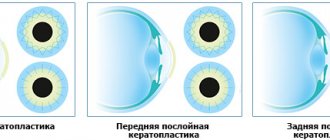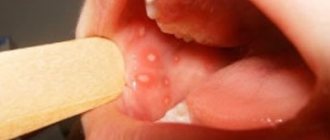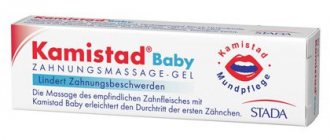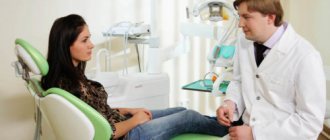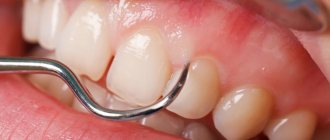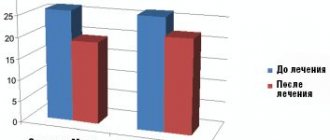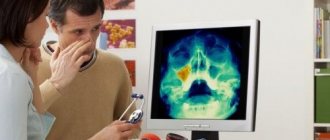From this article you will learn:
- composition analysis,
- detailed instructions for use,
- Solcoseryl gel – reviews, price 2022.
The article was written by a specialist with higher medical education.
Solcoseryl gel is a drug based on deproteinized dialysate from the blood of calves, which accelerates the healing of wounds on the skin and mucous membrane. For example, this drug is widely used in dentistry - to accelerate the healing of erosions and ulcers of the mucous membrane during stomatitis, traumatic injuries to the mucous membrane, and for bedsores under dentures. As for skin wounds, the drug is intended only for the treatment of fresh, wet wounds. To treat wounds and skin damage in the absence of wet discharge, Solcoseryl should be used in the form of an ointment.
The drug is manufactured (Switzerland) and registered as a “medicinal product”. The drug has a high safety profile - in particular, it has no age restrictions, as well as contraindications for use in pregnant and lactating women. When squeezed out of the tube, you can see that the gel is completely transparent, homogeneous and not too liquid (it has a fairly dense consistency). It also has a faint smell of meat broth, which is due to the production technology.
Solcoseryl: photo of packaging
Deproteinized dialysate from calf blood - indications for use
The following list of indications for use is determined by the presence in the drug of deproteinized dialysate obtained from the blood of dairy calves. The dialysate contains a large number of active substances and growth factors that accelerate regeneration processes in the skin and mucous membrane. Indications for use of Solcoseryl gel –
- wet wounds on the skin and red border of the lips,
- trophic ulcers on the skin,
- erosions and ulcers of the oral mucosa,
- bedsores under removable dentures,
- injuries to the mucous membrane from removable and fixed dentures, sharp edges of fillings.
Once again, we draw your attention to the fact that when using the drug on the skin and red border of the lips, the indication for use is only wet wounds. Those. wounds must not be covered with crusts and have a moist discharge. If the wound is covered with dry crusts and there is no wet discharge, then according to the instructions for use, it is necessary to use not a gel, but Solcoseryl in the form of an ointment.
If you plan to treat the oral mucosa, then keep in mind that the gel form is optimal for superficial lesions of the mucous membrane - shallow ulcers, burns, bedsores under dentures. But if the ulcer is deep enough, or you need to cure alveolitis in the hole of an extracted tooth, then in this case it is better to use another form of this drug - Solcoseryl dental paste.
Forms of aphthous stomatitis in adults
There are two forms of the disease:
- chronic;
- spicy.
In acute aphthous stomatitis, round whitish ulcers appear. The mucous membrane swells and turns red.
This form of the disease has the following symptoms:
- pain when eating;
- body temperature rises;
- weakness and a feeling of fatigue occurs, regardless of the work performed;
- lymph nodes become inflamed.
The stage lasts a maximum of ten days, provided that the treatment prescribed by the doctor is followed. The ulcers heal completely without leaving any marks behind. If no action is taken, the disease can progress to a chronic stage, which is much more difficult to get rid of.
Chronic stomatitis is associated with an immune system that is unable to overcome the acute stage. In most cases, a decrease in the protective properties of the immune system is caused by some disease (for example, inflammation of the nasopharynx, gastrointestinal diseases, etc.). Treatment takes longer because after the ulcers disappear, they appear again after some time.
Solcoseryl gel – price, composition analysis
As in the situation with other drugs in the Solcoseryl line, the price for the gel form increased by 3-4 times in 2020-2021. What is the reason for this increase is not entirely clear to me, as a practicing doctor (after all, the drug has a very simple composition). For Solcoseryl gel the price will be from 2000 to 2700 rubles - as of mid-October 2022). The drug is available in aluminum tubes of 20 g. It is sold in pharmacies without a prescription.
Composition of Solcoseryl gel:
| The active substance (per 1 g of gel) is deproteinized dialysate from the blood of healthy dairy calves. | 4.15 mg |
| Excipients - calcium lactate penhydrate, propylene glycol, sodium carmellose, water for injection, as well as preservatives - methyl parahydroxybenzoate (E 218) and propyl parahydroxybenzoate (E 216). | |
Composition analysis - the only active component of the gel is deproteinized dialysate from the blood of dairy calves, which is rich in a large number of low molecular weight organic compounds - amino acids, glycolipids, oligopeptides, nucleosides, etc. Studies have shown that this composition of organic compounds in Solcoseryl gel accelerates the healing process by approximately 30%. The latter is achieved, among other things, by stimulating angiogenesis and fibroblast function in damaged tissues.
Among the auxiliary components, you can pay attention to the preservatives - methyl parahydroxybenzoate (E218) and propyl parahydroxybenzoate (E216). They belong to a class of preservatives called parabens. As part of the gel, they cannot harm the body, but sometimes cause allergic reactions. You should be careful here only if you have severe allergic reactions to cosmetics and oral hygiene products, in which parabens are most often used.
Analogues –
Previously, Russian pharmacies sold the drug Actovegin, identical in composition, in the form of a jelly, which also contained dialysate from the blood of dairy calves (at the moment this form of the drug is no longer sold in Russia). Solcoseryl gel has no other direct analogues, but there are drugs with an excellent composition and similar effects.
All analogues can be divided into 2 groups. The first group of drugs are drugs for external use, intended to accelerate the healing of wounds on the skin (here we include Olazol and Bepanten). Preparations of the second group are products that are intended for use on the moist mucous membrane of the oral cavity (for example, Curasept “ADS 350 Regenerative” and “GengiGel” gel).
- OLAZOL (in the form of an aerosol) - this drug is suitable for accelerating the epithelization of skin wounds. It contains chloramphenicol, sea buckthorn oil and benzocaine (an anesthetic). Moreover, it not only accelerates tissue healing, but also has an antibacterial and analgesic effect, and also reduces the release of exudate from the wound. Due to the presence of an antibacterial effect, the drug can be used to treat infected wet wounds on the skin. The cost of the drug Olazol will be from 220 rubles.
- Cream BEPANTHEN PLUS – because Solcoseryl gel is intended for the treatment of wet wounds, then from the entire line of Bepanten preparations, we can only use Bepanten Plus cream on wet wounds. This drug contains 5% dexpanthenol (a precursor to vitamin B5, which stimulates skin regeneration), as well as the antiseptic chlorhexidine, which has an antimicrobial effect, thereby reducing the risk of infection. It is important that the concentration of chlorhexidine in Bepanten Plus cream is 0.5% (analogs are much lower). On wet wounds, it is most effective to apply the drug on turundas under a bandage - 2 or more times a day. Open treatment of wet wounds will be ineffective. The cost of Bepanten Plus cream is about 470 rubles for a 30 g tube, and a 100 g tube will cost about 950 rubles.
- CURASEPT “ADS 350 Regenerative” gel is designed to accelerate the healing of the oral mucosa. Contains hyaluronic acid to accelerate the healing of ulcers and wounds, as well as the PVP-VA complex, which forms a protective film on wound surfaces and ulcers (this protects their surface from irritants and also accelerates healing). It also contains the antiseptic chlorhexidine 0.5%. The cost of the gel is about 650 rubles - per 30 ml tube. Be careful when purchasing, because... in the Curasept line there is a gel with a similar name, but without hyaluronic acid.
- Oral gel "GengiGel" (GengiGel) is a gel for the mucous membrane of the gums and oral cavity, which contains 0.2% hyaluronic acid + xylitol. We have already said above that hyaluronic acid has a wound-healing effect. Unfortunately, in Russia this drug costs much more than the previous one (more than 1800 rubles for a 20 ml tube), and this despite the fact that its concentration of hyaluronic acid is much lower.
Solcoseryl gel: instructions and application diagram
For Solcoseryl-gel, the instructions for use contain information that the drug has the following types of pharmacological effects when applied to the skin or mucous membrane of the oral cavity - antihypoxic, cytoprotective, regenerating, membrane stabilizing, angioprotective, wound healing (24stoma.ru). In simple terms, this means that the drug has the following properties -
- increases regenerative processes (accelerating tissue regeneration by approximately 30%),
- stimulates collagen synthesis,
- stimulates cell division (reproduction),
- promotes activation of metabolic processes in cells (increases oxygen consumption by cells, and also stimulates the transport of glucose into cells), which allows damaged cells of the body to recover faster.
The use of the gel on the skin and mucous membrane of the oral cavity has several differences. In this regard, below we will separately consider the features of using the gel on the skin and red border of the lips, as well as in the oral cavity. If you wish, you can look at the application specifics in the official instructions (see the link below), but we describe the application patterns in different situations in this article in much more detail.
Solcoseryl gel: official instructions for use ()
Application for treating skin wounds –
Solcoseryl in gel form is intended only for the treatment of fresh, wet wounds, i.e. wounds that have wet discharge. If your wound is already covered with crusts and does not have a wet discharge, you need to use solcoseryl in the form of an ointment. A very important point is that the gel cannot be applied to wounds with purulent discharge (in this case, you first need to have the wound surgically treated by a doctor). In addition, if the wound has torn edges, then surgical treatment is also necessary, without which the wound will quickly fester.
The gel can be applied to wet wounds if the discharged liquid is clear or includes a small amount of blood (i.e., it is “ichor”). But even in these cases, before applying the gel, the wound must be treated with an antiseptic - best using a sterile gauze swab generously moistened with 3% hydrogen peroxide. After antiseptic treatment with another sterile gauze swab, you need to remove excess moisture from the wound and apply a thin layer of gel.
This two-stage treatment should be carried out 2-3 times a day until the wound is covered with granulation tissue and begins to dry out. After this, you need to start using Solcoseryl in the form of an ointment, which is intended specifically for dry wounds on the skin.
Application of gel in the oral cavity –
If you have developed shallow erosions/ulcers due to stomatitis or wearing removable dentures, Solcoseryl gel will be an excellent remedy. If you have a deep ulcer, then it is better to use this drug not in the form of a gel, but Solcoseryl in the form of a dental paste, which, in addition to accelerating healing, also has the function of a protective therapeutic dressing.
You can also use the gel in the mouth 2-3 times a day, making sure to rinse your mouth before using this antiseptic solution. The choice of antiseptic will depend on the cause of the disease. For example, for erosions and ulcers due to herpetic stomatitis, you need to rinse your mouth with a solution of Miramistin, which is active against the herpes virus. In all other cases, it is better to use the antiseptic Chlorhexidine. How to use these antiseptics correctly - see the links below.
After rinsing your mouth, you need to dry the mucous membrane at the site where the gel is applied with a clean, dry gauze swab (in this case, the gel will stick better), and then, without rubbing, simply apply the gel using a clean finger. If we are talking about treating bedsores under prostheses, then immediately after applying the gel you need to put on the prosthesis.
→ Regimen for the use of Chlorhexidine → Regimen for the use of Miramistin
Important: it is advisable to treat the mucous membrane with gel immediately after eating and subsequent oral hygiene. In the absence of good hygiene, a bacterial infection can join wounds and ulcers on the oral mucosa, causing inflammation. After brushing your teeth, you can rinse your mouth with an antiseptic and apply the gel. Next, it is advisable not to eat or rinse your mouth for 2-3 hours; you can drink.
Types of stomatitis
In medicine, it is customary to distinguish two types of stomatitis:
- acute gingivostomatitis, which is caused by various viral infections;
- recurrent stomatitis (caused by staphylococci, immune diseases and problems with the gastrointestinal tract). As the name suggests, the disease tends to occur again and again - periods of exacerbation occur in autumn and spring, when there is a lack of vitamins.
Separately, it is worth highlighting herpetic stomatitis, which affects not only the immune system, but also the nervous system. It occurs most often in children under 3 years of age: during this period, firstly, the influence of maternal immunity on the baby’s body rapidly weakens, and secondly, the child begins to go to kindergarten, where he interacts with other children who may already be infected with the virus herpes.
Gel Solcoseryl: reviews
An important condition for achieving a good treatment result is the correct choice of the form of the drug Solcoseryl - this can be in the form of a gel, ointment or dental adhesive paste.
The effect of the gel will be noticeable specifically on wet wounds, and consists in accelerating the formation of granulation tissue by about 30%. You will not notice the effect of the gel when used on dry wounds, and it is unlikely that you will be able to leave a good review of the product after this. Solcoseryl gel will have a good pronounced effect and will accelerate the healing of wounds and ulcer erosions, unless, of course, they are related to tumor-like lesions. The latter must be especially borne in mind, because if the erosion or ulcer has existed for a long time, or there is no effect when using Solcoseryl, then these are signals indicating that this lesion of the mucous membrane/skin is related to tumor-like tissue damage.
Another important point is applying the drug to infected wounds. For the drug to give a good result, there must be no infection in the wound. Purulent wounds, as well as wounds with torn edges, first require primary surgical treatment and drug therapy. Reviews for Solcoseryl gel will be positive only if you carefully follow all recommendations for its use. Failure to follow the recommendations for use, especially with regard to infected wounds, can, on the contrary, lead to increased inflammation.
Solcoseryl anti-wrinkle gel in cosmetology: reviews
Some patients persistently try to use Solcoseryl gel for the face to get rid of wrinkles. The logic here is clear - since the drug increases proliferation (reproduction) and activity of fibroblasts, then its use should seem to lead to an increase in collagen production. Unfortunately for patients, it must be noted that none of the forms of solcoseryl work on intact skin.
Therefore, Solcoseryl ointment or gel is not used in cosmetology, and they are effective only for accelerating the healing of skin damage, including after surgical and cosmetic interventions. To stimulate collagen production in aging skin, it is better to use retinoid-based products, and an even faster effect is achieved by a hardware technique that uses fractional lasers. These techniques do have proven evidence of increasing collagen in the skin (see links above for arguments and clinical studies).
If you are interested in a cream that can improve skin regeneration and keep it moisturized, especially in winter, one of the best options would be to use Bepanthen for Dry Skin cream. It contains not only dexpanthenol (a precursor to vitamin B5, which enhances skin regeneration), but also moisturizing components such as the emollient “lanolin”, as well as D, L-pantolactone. I recommend this product because... I myself use it 2 times a day in the winter and see its effectiveness from personal experience. It can even be applied to the moving parts of the eyelids. A 100 ml tube costs only about 950 rubles.
Contraindications and side effects –
The only contraindication to the use of the drug is the presence of hypersensitivity to one of its components. The drug has a high safety profile and has no age-related contraindications, and is also approved for use in pregnant and lactating women. The only point you need to pay attention to is that the drug should be used with caution if you are predisposed to allergic reactions.
When used on the skin, Solcoseryl gel can cause local allergic reactions such as urticaria or marginal dermatitis. If the drug is used on the oral mucosa, usually one of the signs of an allergy will be limited swelling of the soft tissue at the site of application. Another sign of an allergy may be a prolonged, continuous burning sensation at the site of application, which requires discontinuation of the drug. If the burning sensation is short-term, then this is acceptable and does not require discontinuation of the drug.
Causes
There is still no consensus on why aphthous stomatitis occurs. However, most doctors believe that the main reason for the development of the disease is weakened immunity.
Often the occurrence of stomatitis is a consequence of other diseases: influenza, tonsillitis, tonsillitis, gastrointestinal diseases. Provoking factors include a sharp change in climate zone and a large amount of stress in everyday life.
Many microorganisms enter the human body through the oral cavity: a decrease in the overall immunity of the body entails a decrease in the level of resistance of the mucous membrane. As a result, the concentration of microbes in the mouth increases, the result of which is the development of the disease.
Special instructions -
- Solcoseryl gel should not be applied to a contaminated, infected wound, as well as a wound with purulent discharge or a wound with torn edges. In most of these cases, a doctor’s intervention is required to perform surgical treatment of the wound.
- If pain, swelling, redness occurs in areas of the mucous membrane and skin (near the site where the gel is applied), discharge from the wound or fever occurs, you should immediately consult a doctor. Most likely this indicates suppuration.
- If, when using the gel, the wound does not heal within 2 weeks, you should urgently consult a doctor, because this may indicate the presence of tumor growth. We hope that our article on the topic: Solcoseryl Gel detailed instructions for use was useful to you!
Sources:
1. Dental education of the author of the article, 2. Personal experience as a maxillofacial surgeon, dental surgeon, 2. “Outpatient surgical dentistry” (Bezrukov V.), 3. https://solcolife.ru/.


